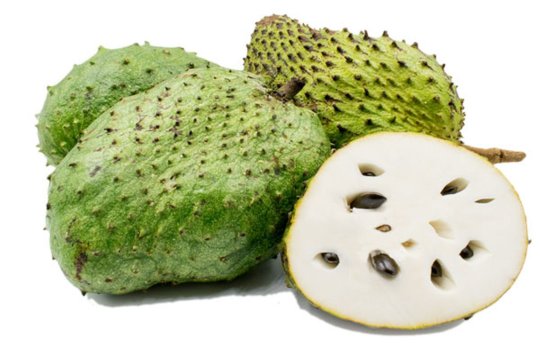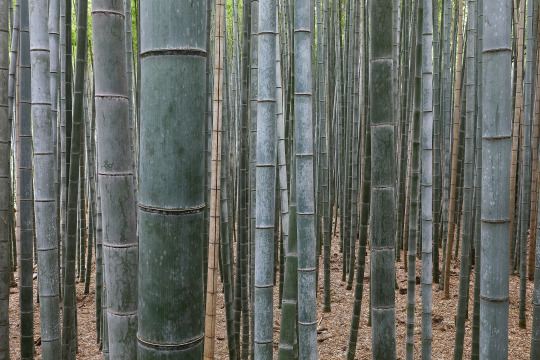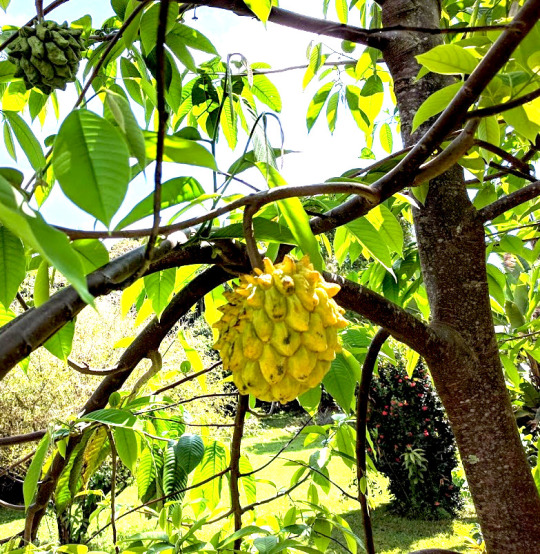#Custard Apple and Soursop
Explore tagged Tumblr posts
Text
Understanding the Difference Between Custard Apple and Soursop for Kenyan Farmers
Today we are going to compare the difference between Custard Apple and Soursop. These fruits are known for their unique flavors and health benefits. We get lots of questions about whether soursop is the same as custard apple. We are going to investigate soursop and custard apple! There are several differences between them that we are going to explore for you. We are going to talk about…

View On WordPress
#adaptable trees#climatic preferences#cultivation characteristics#custard apple#custard apple adaptability#Custard Apple and Soursop#custard apple characteristics#flavorful fruits#fruit cultivation#fruit tree characteristics.#Fruit trees#healthy fruit varieties#Orchard management#orchard planning#soursop#soursop benefits#soursop cultivation tips#subtropical regions#sun-loving trees#tropical climate suitability#tropical fruits#tropical gardening#tropical orchard#warm climates
1 note
·
View note
Text

Veronica Ryan, Custard Apple (Annonaceae), Breadfruit (Moraceae) and Soursop (Annonaceae), 2021, the UK’s first permanent public sculptures to celebrate and honour the Windrush Generations.
Courtesy the artist, Paula Cooper Gallery and Alison Jaques Gallery. Photo: Andy Keate, 2021
#Veronica Ryan#Veronica Ryan OBE#Custard Apple#Breadfruit#Soursop#public art#Hackney#Hackney Council
11 notes
·
View notes
Text

Jamaican soursop is a somewhat confusing fruit for those unfamiliar with it. It’s a delicious treat, but many visitors to the island are often amazed at its unique appearance. The skin in ripe fruits is yellowish-green in color, the ovoid fruits can grow up to 12 inches in length, and are covered with blunt “spines.” The fruit can weigh up to 15 lbs. the flesh is cream-colored, and the leaves emit an unpleasant odor. Jamaicans call the fruit soursop and it’s also known as guanabana, cherimoya, custard apple, and Brazilian Paw.
Fans of the fruit have described the taste as a combination of apples and strawberries with notes of sour citrus. The texture is reminiscent of a banana. The fruit’s origins are a mystery, though it’s been cultivated in Africa, South America and the Caribbean for thousands of years. It’s been used as a medicinal throughout history, but can be toxic with long-term usage or when taken in large amounts.
Soursop is eaten raw, made into a refreshing beverage, and often used in desserts that include gelatin, custard, ice cream and jelly. It’s also popular as a refreshing beverage. It contains an extensive array of nutrients that include vitamins B1, B2, B3, B5, B6 and C. Soursop also has calcium, iron, magnesium, phosphorous, potassium, and zinc.
29 notes
·
View notes
Text
RainWing Names - Letter A
Abacaxi (A large, sweet pineapple that grows in Brazil.) Abiu (A fruit/fruit tree from the Amazonian region of South America.) Abundance (An extremely large quantity of something.) Acacia (A genus of trees.) Açaí (A type of berry, resembles blueberries.) Achiote (A spice that is also often used to add yellow color to food. Also known as Annato.) Ackee (A type of fruit native to West Africa.) Arco Iris (Spanish for 'rainbow'.) Admirable / Admiration / Admire (To regard something or one with respect and approval, or be deserving of it.) Adore / Adorable (To love or respect deeply, or be deserving of it.) Adventure / Adventurous (An unusual or exciting experience or activity; someone willing to take risks or to try out new methods, ideas, or experiences.) Aegithina (A type of bird also known as the Iota.) Aesthetic (A particular theory or conception of beauty or art.) Affectionate (A gentle feeling of fondness or liking.) Agouti (A type of rodent.) Aguaje (A type of palm tree.) Airy (Giving an impression of being unconcerned or not serious, typically about something taken seriously by others.) Aka (Japanese for 'red'.) Akebi (A type of fruit native to Japan, China and Korea.) Aki (Japanese for 'autumn', or another name for the Ackee.) Alder (A type of tree from the birch family with toothed leaves.) Alligator (A large semi-aquatic reptile.) Allium (A type of flowering plant. Often purple, but can come in many other colors.) Allure / Alluring (The quality of being powerfully and mysteriously attractive or fascinating.) Almond (The seed of the almond tree.) Aloe / Aloe Vera (A type of succulent that primarily grows in arid climates. Also good for a SandWing hybrid.) Alyssum (A type of flower.) Amaranth (A type of flower.) Amarillo (Spanish for 'yellow'.) Amaryllis (A type of poisonous flower.) Amazing (Causing great surprise or wonder; astonishing or startlingly impressive.) Amazon (As in the Amazon Rainforest, the most famous rainforest.) Ambition / Ambitious (A strong desire to achieve or do something, or showing that desire.) Ame (Japanese for 'rain'.) Amla (Also known as the Indiana Gooseberry, a type of fruit.) Ammolite (An opal-like gemstone made of the fossilized shells of ammonites.) Amusement (The state or experience of finding something funny or entertaining.) Anar (Another name for the Pomegranate.) Anaconda (The largest snake species in the world. They are great swimmers, so this could also be good for a SeaWing hybrid.) Ananas (The plant genus that contains the pineapple.) Angel Aura Quartz (Quartz that undergoes extreme heat and is then coated with a special blend of metals such as Platinum, Gold, and Silver.) Angelic (To be beautiful, innocent, pure, or kind.) Anger / Angry (A strong feeling of annoyance, displeasure, or hostility.) Anise (A flowering plant. It's seeds are used as a spice.) Annona (Also known as the soursop, or custard apple.) Anole (A type of lizard.) Ant (Insects that live in colonies.) Anteater (Toothless insect eating mammals with long tongues.) Ānuenue (Hawaiian for 'rainbow'.) Anura (The order frogs belong to.)
#wings of fire#wings of fire names#wof names#wof#rainwing#rainwing names#a names#names in other languages#fruit names#plant names#flower names#gemstone names#color names#personality describing names#rodent names#reptile names#amphibian names#mammal names#bird names#insect names#red color names#adjective names#location names#weather names
18 notes
·
View notes
Text

Sweetsop (Annona squamosa)
Family: Sweetsop Family (Annonaceae)
IUCN Conservation Status: Least Concern
Growing as a large bush or small tree, the Sweetsop is native to tropical regions of Central and South America but is now grown in warm, humid regions worldwide for its large, scaly-looking fruits. Sweetsop fruits (also known as Sugar Apples) are sweet, aromatic and nutritious, and their flesh is said to resemble custard in both texture and taste. A closely related species, the Soursop (Annona muricata) produces similar-looking fruits, though as the name suggests while still considered pleasant-tasting by many the flesh of the latter is considerably more sour.
--------------------------------------------------------
Image Source: Here
11 notes
·
View notes
Note
the green spikey fruit with the white inside is called a guanabana in spanish! or soursop/custard apple in English :)
I LOVE YOU FOR ANSWERING THIS
3 notes
·
View notes
Text
Soursop Fruit: A Tropical Superfood with Incredible Health Benefits
Soursop (Annona muricata), also known as graviola, guanabana, or custard apple, is a tropical fruit native to Central and South America, the Caribbean, and parts of Africa and Asia. It is prized for its unique flavor—a combination of strawberry, pineapple, and citrus with a creamy texture—making it a favorite in juices, smoothies, and desserts. But beyond its delicious taste, soursop is packed…
0 notes
Text

Wholesale Soursop Leaf Tea La Mang Cau Xiem Herbal Tea Aka Guanabana leaf of custard apple, guanabana, guyabano, graviola, or Brazilian paw paw Herbal medicine
Soursop Tea La Mang Cau Xiem Graviola Soursop Tea Leaf Herbal Tea Aka Guanabana Herbal medicine for Skin Health, antioxidants, boost immune system 100 Gram. Soursop leaf tea (also graviola, guyabano, and in Hispanic America, guanábana) is the fruit of Annona muricata, a broad leaf, flowering, evergreen tree. Its fruits and leaves are known to offer potent benefits. It is in the same genus, Annona, as cherimoya and is in the Annonaceae family. Soursop tea is an herbal tea that is made from the leaves of the soursop fruit tree. the leaf is used in tenderizing meat. Soursop leaf tea is rich in antioxidants, which help neutralize harmful free radicals in the body. This can reduce oxidative stress. Soursop leaves are also used to prepare tea. Soursop can offer many benefits, most of which can be found in its leaves and pulp. Soursop tea is prepared from the leaves of the soursop plant, which is taxonomically known as Annona muricata. It is also known as graviola tea or pawpaw tea.
1 note
·
View note
Text
Custard Apples
I thought of custard apples today, which was very surprising because I never had the fruit (I don't believe I tried or tasted it in the past). I believe I heard about the apple a long, long time ago. I found some interesting information on the fruit on Google. Three things I wanted to highlight: the peeled fruit (the inside) made me think of the soursop, the fruit is native to South America and the Caribbean, and it is high in potassium.


(Link: https://www.healthline.com/nutrition/cherimoya)
1 note
·
View note
Text
Tavares Strachan's The First Supper (Galaxy Black) at the Royal Academy of Art, London


"This sculpture celebrates the act of sharing a meal. Twelve historically significant activists, writers, musicians, explorers and political leaders from the continent of Africa and its diasporas are gathered around a table laden with rice, breadfruit, catfish, chicken, cocoa, custard apple and soursop. Although these people comé from very different eras and backgrounds and hold different world views, Strachan imagines them coming together for physical and intellectual nourishment. Seated below
"Strachan's self-portrait is a thylacine, a species now extinct. From left to right:
Tavares Strachan (b, 1979)
Sister Rosetta Tharpe (1915-1973)
Harriet Tubman (1822-1913)
Shirley Chisholm (1924-2005):-Marcus Garvey (1887-1940)
Zumbi dos Palmares (1655-1695).
Haile Selassie (1892-1975)
Mary Seacole (1805-1881):
Matthew Henson (1866-1955)
Marsha P. Johnson (1945-1992)
King Tubby (1941-1989)
Derek. Walcott (1930-2017)
Robert Henry Lawrence (1935-1967)"
- from plaque beside sculpture





0 notes
Photo

Exotic Annona Squamosa Tropical Fruit Seeds (Soursop, Sugar Apple Seeds, Sweetsop Seeds, Custard Apple Seeds) Guanabana Annona muricata B5 Annona Squamosa Seeds, Soursop, Sugar Custard Apple Sweetsops Fruit Tree Shrub Annona squamosa, the Sugar-apple, is a tropical shrub from South America, Asia, and Africa. This shrub will grow to a height of 5 meters high and 4 meters large. It gives delicious fruits. Annona squamosa can even be grown in a pot. Annona squamosa has a cylindrical trunk and wears big oblong leaves. The flowers are pale green or yellow and have a strong sweet smell. The fruits are called sugar apples. Here is a popular tree that is widely cultivated for its edible delicious fruit. It is a small, semi-deciduous tree or shrub with broad, spreading branches. It can grow up to 8 m tall. The leaves are thin, simple, with fine hairs underneath, and arranged alternately. The 6-10cm long fruits are sweet and creamy, and consumed as a dessert or used as an ingredient in making ice cream, jellies, etc. Their skin is thick and green and covered with scales. The flesh of the fruit is white, creamy, and sweet. It contains black pips of 1 cm in diameter. Annona blooms all year long in tropical regions. In milder climates, it blooms in spring and at the start of summer. It is a deciduous plant, which means that it loses its leaves when it rests. The plant will take 3 to 4 years before it produces fruits. Hardiness zones 10-11 (1°C/35°F,4°C/40°F) in winter. A small, spreading tree with curious-looking, green fruits about the size of a large apple. The inside of the fruit holds numerous blackish seeds embedded in creamy, soft, white flesh that is very sweet and wonderfully aromatic and is considered one of the world's tastiest fruits. It is thought to originate in Central and South America but is widespread in cultivation today. It is best adapted to tropical climates and is the most heat-tolerant in the genus. The plant dies when the temperature is below 0°C. Annona needs to be in a situation away from the wind. They are not rustic plants. The plant thrives in full sun. Watering is done once a week and abundantly. Also, remember to cut the dead branches or the ones that are too low. Keep it far from the cold and the wind. The Annona can be grown in a pot. Also used medicinally in treating diarrhea, dysentery, colds, chills, rheumatism, and sleeplessness. It also has an anticancer function and it lowers uric acid levels in the blood. The seeds, when heated, can produce oil that can be used against agricultural pests. However, it should be noted that the seeds, leaves, and roots are poisonous due to the occurrence of alkaloids and hydrocyanic acid in such plant parts. *We can not take any responsibility for any adverse effects from the use of plants. Always seek advice from a professional before using a plant medicinally. It is cold and frost-sensitive and requires a tropical or near-tropical climate. Though it is drought tolerant, it will not produce fruit well during droughts. Not particular to soil and has performed well on sand, oolitic limestone, and heavy loam with good drainage. Waterlogging is intolerable. The tree is shallow-rooted and doesn't need deep soil. USDA zone 10-12 Count: ~ 5 Label Annona squamosa The common name Sugar Apple Family No Genus Annona Species Annona squamosa Cultivar No Therapeutic uses No Germination Plant seeds in a good garden soil that is well-drained fertile soil. During growth, use a tutor. The tutor can even be used after growth. Fertilizer can be used once a week during growth. This plant enjoys a sunny spot. Germination takes 15-30 days, it can be longer, don’t get discouraged. Scarification / Stratification No http://springsofeden.myshopify.com/products/exotic-annona-squamosa-tropical-fruit-seeds-soursop-sugar-apple-seeds-sweetsop-seeds-custard-apple-seeds-guanabana-annona-muricata-b5
#Sugar Apple Seeds#Sweetsop Seeds#Custard Apple Seeds#Annona Squamosa#organic seeds#fruit seeds#rare seeds#Tropical Fruit Seeds#Soursop#Guanabana#Annona muricata
0 notes
Text

found soursop juice :D
took myself out to breathe some fresh air so I'm not rotting at home👍
#this thing has so many names#soursop. sugar apple. custard apple. guanabana. guyabana. corossol. brazilian paw paw. cherimoya... the list goes on#the fruit itself tastes like sweet candied pudding#the juice is just as I expected. today good :)#GRAVIOLA. forgot graviola is one of the more common names. and annonas muricata
10 notes
·
View notes
Text
Plarch Plantness
Example members
Poaceae:
Corn
Wheat
Rice
Barley
Bamboo

Annonaceae
Soursop
Pawpaw
Custard Apple
Cherimoya

17 notes
·
View notes
Text
D I R E C T O R Y (pt. 7)
Fruits ~
Açai • Ackee • Apples • Apricots (Dried) • Banana • Blackberries • Blood Orange • Blueberries • Breadfruit • Cantaloupe • Clementines • Cranberries (Dried) • Cherries (Dried) • Currants • Custard Apple • Dates • Dragonfruit • Durian • Figs (Dried) • Finger Limes • Goji Berries • Grapefruit • Grapes • Guava • Guinep • Honeydew Melon • Jackfruit • Jujubes • Kiwi • Kumquats • Lingonberries • Lychee • Mamey Sapote • Mandarin Orange • Mango • Mangosteen • Mulberries (Dried) • Nectarines • Noni • Orange • Papaya • Passionfruit • Peaches • Pears • Persimmons • Pineapple • Plantains • Plums • Pomegranate • Quince • Raisins • Rambutan • Raspberries (Freeze-Dried) • Sapodilla • Soursop • Starfruit • Strawberries (Freeze-Dried) • Tamarind • Tangerines • Watermelon
12 notes
·
View notes
Text

Veronica Ryan, Custard Apple (Annonaceae), Breadfruit (Moraceae), and Soursop (Annonaceae), 2021. Photo: Andy Keate.
Marble and bronze.
Hackney Windrush Art Commission in London.

Heather Phillipson, THE END, 2021. Photo: © David Parry PA Wire
9.4 metres, 9 tonnes weight
2 notes
·
View notes